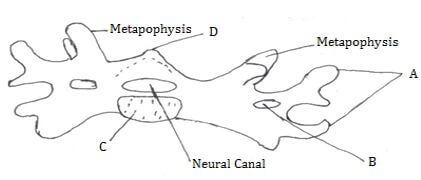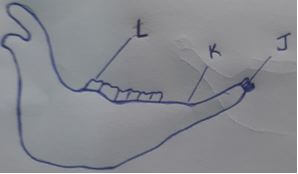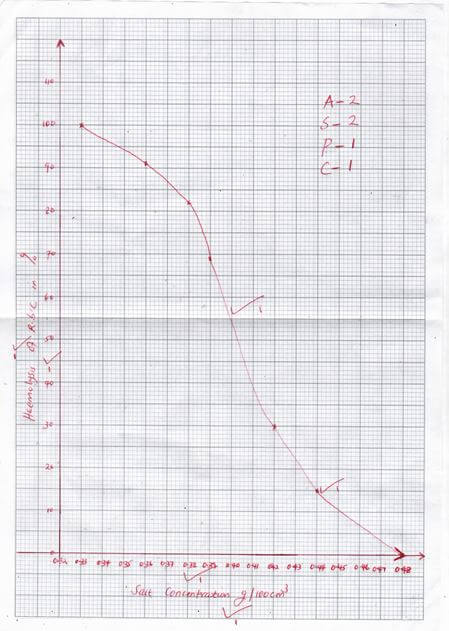INSTRUCTIONS TO CANDIDATES.
- Write your Name and Admission Number in the spaces provided.
- Sign and write the date of examination in the spaces provided above.
- This paper has Two SECTIONS; A and B.
- Answer all questions in section A in the spaces provided.
- In Section B answer question 6(Compulsory) and either question 7 or 8 in the space provided after question 8
- Ensure all the pages are printed as indicated below and no question is missing
For Examiner’s Use only
|
Section |
Question |
Maximum Score |
Candidate’s Score |
|
A |
1 |
8 |
|
|
2 |
8 |
||
|
3 |
8 |
||
|
4 |
8 |
||
|
5 |
8 |
||
|
B |
6 |
20 |
|
|
7 |
20 |
||
|
8 |
20 |
||
|
Total score |
80 |
||

QUESTIONS
SECTION A (40 MARKS)
Answer ALL the questions in this section in the spaces provided.
- The diagram illustrates a bone found in a mammal

- Label the Parts A, B, C and D (4mks)
A
B
C
D - Identify the bone (1mk)
- Give one reason for your answer in (ii) above (1mk)
- State the function of the part labeled B (1mk)
- Name the part of the skeleton where the above bone can be found (1mk)
- Label the Parts A, B, C and D (4mks)
- A set up was done as shown below

- What was the aim of the experiment? (1mk)
- State two observations in the test tube (2mks)
- State an observation in the boiling tube 1mk)
- List two conclusions made at the end of the experiment (2mks)
- A man weighing 90kg requires 200KJ per gram of body weight while a rat weighing 50g requires 2500KJ per gram of body weight. Explain (2mks)
- Study the diagram below and answer the questions that follows

- What type of evolution is illustrated by the limbs (1mk)
- What does the origin of the limbs suggest about the ancestry of these animals (1mk)
-
- What are vestigial structures? (1mk)
- State an example of vestigial structure in humans (1mk
-
- What is natural selection? (2mks)
- Give one example of nature selection in action (1mk)
- Explain comparative serology as evidence of evolution. 1mk
- The diagram below represents the lower jaw of mammals.

- Name the mode of nutrition of the mammal whose jaw is shown. (1 mark)
- State one structural and one functional difference between the teeth labeled J and L. (2marks)
-
- Name the toothless gap labelled K. (1 mark)
- State the function of the gap. (1 mark)
- Name the substance that is responsible for hardening of teeth. (1 m
- Distinguish between the terms homodont and heterodont. (1 mark)
- In a population of guinea pigs a certain mutant gene (b) was discovered. It causes the Beta cells in the pancreas fail to release insulin in order to control blood sugar level. In Homozygous condition the victims are born dead. In heterozygous condition the animals grow to maturity and reproduce. In a certain season 390 still births were counted.
- Write down the genotypes of parents who some of their offspring were born dead. (2 marks)
- Carry out a cross using a punnet square to show the occurrence of the still birth. (4 marks)
- Work out the total number of the offspring that grew to maturity. (2 marks)
SECTION B (40 MARKS).Answer question 6 (Compulsory and either question 7 or 8.)
- An experiment was carried out to investigate haemolysis of human red blood cells.
The red blood cells were place in different concentrations of sodium chloride solution. The percentage of haemolysed cells was determined. The results were as shown in the table below.
Salt concentration (g/100cm) (%)
0.33
0.36
0.38
0.39
0.42
0.44
0.48
Red blood cells (Haemolysed) (%)
100
91
82
69
30
15
0
-
- On the grid provided, plot a graph of haemolysed red blood cells against salt concentration.
- At what concentration of salt solution was the proportion of haemolysed cells equal of non Haemolysed cells? (1 mark)
- State the percentage of cells haemolysed at salt concentration of 0.45% (1 marks)
- Account for the results obtained at:
- 0.33 percent salt concentration. (3 marks)
- 0.48 percent salt concentration. (3 marks)
- What would happen to the red blood cells if they were placed in 0.50 percent salt solution? (3 marks)
- Explain what would happen to onion epidermal cells if they were place in distilled water. (3marks)
-
- Describe how human kidneys function. (20 marks)
- Describe secondary growth in Dicotyledonous plants. (20 marks)

MARKING SCHEME.
-
- A - Transverse processes;
B – Vertebrarterial canal; Rej vertebraterial canal
C – Centrum;
D – Neural Spine; - Cervical vertebra; RJ Vertebrae
- Presence of vertebrarterial canals;
- Passage of nerves and blood vessels;
- Neck region; (of the verterbral column)
- A - Transverse processes;
-
- To show that water and carbon (IV) oxide are produced during aerobic respiration;
- - Bubbles will be observed;
- The solution turns into a white precipitate; - Water droplets will be seen;
- - Water is produced during aerobic respiration;
- Carbon (IV) oxide is produced during aerobic respiration
-
- Divergent evolution (1 mark)
- Ancestry origin of the lib suggests there were habitants of aquatic environment. (1 mark)
-
- Vestigial structures
Highly reduced structure due to disuse (1 mark) - Appendix, coccyx, nictating membrane eye, muscles that moves the ear. (1 mark)
- Vestigial structures
-
- Natural selection
Situation whereby the nature favours organisms suited for survival and eliminate those that are less adapted. (2 marks) - An example of nature selection in action. (2 marks)
- Resistance to antibiotics and pesticides
- Industrial mechanism
- Natural selection
- More precipitation is observed when serum of closely related organism are mixed and vice versa. (1 mark)
-
- Herbivorous;
- Structural: J – Narrow/sharp/chisel like
L – Broad/ridge
Functional: J – Cutting and bitting
L – Grinding and crushing. -
- Diastema
- To allow manipulation of food by tongue/separating chewed and new cut vegetation.
- Calcium phosphate;
- Homodont – Organism having same/similar kind/type of teeth, hence same function.
Heterodont – Organisms having different type/kind of teeth hence different function.
-
- Bb , Bb
- Parental phenotype male female
Parental genotypes Bb x Bb
Gametes
- Ratio is 3.1 (i.e. in every 4, 1 died)
¼ = 390 therefore those that survived are ¾
¾ = ¾ x 390 x 4/1; = 1170;
-
-
- Scale: x-axis: 1cm rep 0.02g/100cm , y-axis: 1cm rep 10% R.b.c. haemolysed
- 0.403 + 0.002 (iii) 10 = 1%
-
- 0.33 percent salt concentration – Less concentration/dilute/hypotonic than blood cells cytoplasm; water is drawn in by osmosis; the cells swell and eventually burst (a process called haemolysis)
- 0.48 percent salt concentration – Concentration of red blood cells cytoplasm is same as concentration of salt solution (isotonic) therefore no net movement of water by osmosis; hence cells remained normal and none were haemolysed.
- 0.5% salt concentration is highly concentrated solution/hypertonic than blood cells cytoplasm;
Red blood cells would lose water by osmosis; shrink and become crenate. - The cell sap is more concentrated than surrounding; water enters into the cell by osmosis; the cell swells/becomes turgid; but does no burst due to the rigid cellulose cell wall.

-
- Kidneys receive blood from renal artery, a branch of dorsal aorta, hence blood is under high pressure. The afferent arteriole which is the branch of renal artery supplies blood to glomerulus; The afferent arteriole has a wider diameter than the efferent arteriole; this causes back resistance hence high pressure in the glomerulus leading to ultra-filtration. The walls/capsular barrier are one cell thick hence glucose, amino acids, vitamins, hormones, salts, (creatinine) urea and water filter into Bowman’s Capsule to form glomerular filtrate; White blood cells/red blood cells and plasma proteins such as (Globulin, fibrinogen, platelets) are too large to pass through the capillaries: the filtrate flows into the proximal convoluted tubule, where all amino acids, vitamins and all glucose are selectively reabsorbed back into the blood stream by active transport. There are many mitochondria to provide energy for re-absorption of these substances against concentration gradient by active transport. The Glomerular filtrate flow into loop of Henle. Water in descending loop moves by osmosis into the blood capillaries; sodium chloride is actively pumped from the ascending limb of loop of Henle into the blood capillaries with the help of aldosterone hormone produced by adrenal gland. The glomerular filtrate flow into the distal convoluted tubule, water is re-absorbed from distal convoluted tubule into blood capillaries; the glomerular filtrate flows into collection tube/duct from where more water is reabsorbed into blood stream. Antidiuretic hormone influences the amount of water reabsorbed depending on osmotic pressure of blood; the glomerular filtrate from collecting duct no referred to as urine; is emptied into pelvis. The urine passes though pelvis and ureter into urinary bladder out of the body through urethra when sphincter muscles relax.
- Begins with the division of vascular cambium; It produce new cambium cells between vascular bundles; to form a continous cambium ring; cambium cells divide to form new cells; that are added to older ones; cambium cells now become meristematic; New cells produced outside cambium differentiate to become secondary phloem; while those inside differentiate to become secondary xylem; more secondary xylem formed that secondary phloem, inter vascular cambium; cuts off parenchymatous; cells to form secondary medullary rays; increase in volume of secondary tissues exert pressure on outer cells of stem; resulting in stretching; and rupturing; of epidermal cells New band of cambium cork cambium/phellogen; formed to replace the protective outer of stem; cork cambium divides; and produce new cells on either sides; cells on inner side of cork cambium differentiate into secondary cortex; cells on outer side become cork cells. Cork cells are dead with thickened walls; their walls become coated with water proof substance called suberin; cork cell increase in number and became bark of the stem;
(23 marks)
Maximum 20 marks
Download Biology Paper 2 Questions and Answers - Asumbi Girls Highschool Pre-Mock Exams May-June 2022.
Tap Here to Download for 50/-
Get on WhatsApp for 50/-
Why download?
- ✔ To read offline at any time.
- ✔ To Print at your convenience
- ✔ Share Easily with Friends / Students

